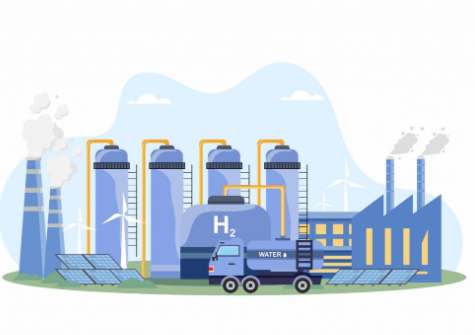Domestic manufacturing of electrolysers can be game changer for industrial emissions (GS Paper 3, Environment)

Context
- As India’s economy continues in an upward trajectory, the rise of emission-intensive sectors looms large. Industries such as power, steel, cement and fertilisers stand as formidable contributors, accounting for over half of the nation’s emissions.
Net Zero by 2070
- India has pledged to reduce the emission intensity of its GDP by 45 per cent by 2030 from 2005 levels, along with becoming Net Zero by 2070.
- In the power sector, India plans to increase its renewable energy-based installed capacity to 50 per cent by 2030 as a part of its nationally determined contribution, which would substantially limit the emissions of the sector.
Challenges
- Yet, challenges persist for other hard-to-abate sectors like steel and fertilisers, urging exploration of alternative avenues to curb their emission footprint, along with increasing their production.
- There are many avenues to reduce emissions, but among the most promising options is the use of green hydrogen in these sectors.
- Conventionally, hydrogen production has relied on fossil fuels such as natural gas or coal. Steam methane reforming and coal gasification are the predominant methods for using natural gas and coal, respectively, in producing hydrogen, primarily for applications in the fertiliser industry’s ammonia production.
- However, hydrogen, particularly sourced from renewable energy sources such as solar, wind, or hydro, referred to as green hydrogen, offers a transformative alternative. Produced through electrolysis, green hydrogen is derived using direct current passed through water, which splits the molecules into individual elements and produces hydrogen at the cathode.
Required capacity for achieving Net Zero scenario (2021-2030)
- The production of green hydrogen necessitates the deployment of electrolysers. Presently, China takes the lead in both installed electrolyser capacity, boasting nearly 220 megawatts as of 2022, with an additional 750 MW under construction slated for online integration by 2023.
- Moreover, China dominates the manufacturing landscape for electrolysers, contributing to 40 per cent of the global capacity.
- In contrast, the European Union witnessed a surge in installations, with approximately 80 MW added in 2022, doubling the capacity installed in the preceding year.
National Green Hydrogen Mission (NGHM)
- In a significant move, the Government of India has unveiled the National Green Hydrogen Mission (NGHM), backed by a substantial budget of Rs 19,744 crore spanning from 2023-24 to 2029-30.
- The initial outlay is delineated into specific allocations: Rs 17,490 crore earmarked for the Strategic Interventions for Green Hydrogen Transition (SIGHT) programme, Rs 1,466 crore dedicated to pilot projects, Rs 400 crore allocated for research and development endeavours and Rs 388 crore directed towards other essential components of the mission.
- Investing in a homegrown electrolyser manufacturing infrastructure is anticipated to drive down the price of green hydrogen and enhance the nation’s competitive edge.
Tender issued by the Solar Energy Corporation of India (SECI)
- In a tender issued by the Solar Energy Corporation of India (SECI) in July 2023, inviting participation for the establishment of a 1.5 GW manufacturing capacity for electrolyser production, a remarkable response was witnessed.
- A total of 21 firms submitted bids, vying for incentives to establish a cumulative annual electrolyser manufacturing capacity of 3.4 GW, surpassing the initial offering of 1.5 GW.
- Furthermore, 14 companies expressed keen interest in incentives to develop production facilities for 553,730 tonnes of green hydrogen, exceeding the offered capacity of 450,000 tonnes.
- The Asia Society Policy Institute, however, noted in a recent report that while the SIGHT initiative marks a significant step forward, its effectiveness hinges on its adaptability to cater to the diverse needs of both flourishing startups and established international players.
- Moreover, while the programme initially aims to reduce system expenses for electrolyser manufacturers, its viability over the long term necessitates fine-tuning to ensure sustained appeal for investment and project resilience.
- In the second phase of bid invitation by SECI (Tranche-II) for incentivising electrolyser manufacturing, consideration has been given for smaller units, including startups, under bucket 2B of the scheme guidelines released by the ministry.
- The main objective is to encourage the indigenous design and manufacturing of the electrolysers, making India self-reliant.
Output of Pilot projects
- The output of pilot projects in sectors such as steel, shipping and mobility (transport), which are under various stages of implementation following MNRE scheme guidelines, will propel the way for adoption and commercialisation of green hydrogen, Singh added.
- Research and development activities will majorly focus on making the electrolysers more efficient and durable as well as affordable, by using commonly available cheaper materials to manufacture them rather than rare and costly materials.
- While the outlays allocated to these initiatives alone are not enough to achieve the 5 MMTPA green hydrogen production target, these programmes are expected to leverage public capital to attract private capital to the tune of Rs 8 lakh crore by 2030.
Following solutions to ensure unhindered progress towards the 5 MMTPA target:
- Arriving at clear, measurable and globally accepted standards for green hydrogen production
- Creating demand visibility for the offtake of the planned green hydrogen production
- Striking balance between imports and domestic content requirements for electrolysers and other green hydrogen equipment
Way Forward
- MNRE has release guidelines and allocation funds for green hydrogen-based steel production in India. Implementation of such projects will significantly reduce the emissions from that sector.
- Similar initiatives have to come for other hard-to-abate sectors which have proven technologies for green hydrogen.


